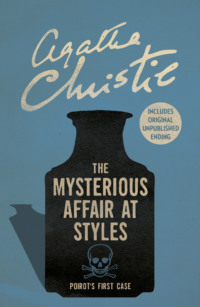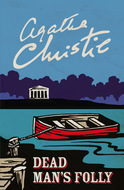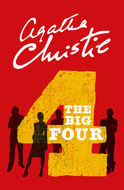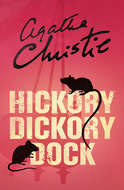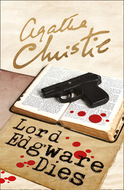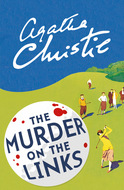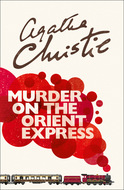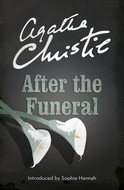Książki nie można pobrać jako pliku, ale można ją czytać w naszej aplikacji lub online na stronie.
Czytaj książkę: «The Mysterious Affair at Styles»
THE MYSTERIOUS AFFAIR AT STYLES

Agatha Christie®

Copyright
HarperCollinsPublishers
1 London Bridge Street
London SE1 9GF
100th Anniversary Edition 2020
First published in Great Britain by
The Bodley Head Ltd 1921
The AC monogram logo and the Poirot Icon are trade marks and AGATHA CHRISTIE, POIROT and the Agatha Christie Signature are registered trade marks of Agatha Christie Limited in the UK and elsewhere.
Copyright © Agatha Christie Limited 1920. All rights reserved.
‘Drugs and Detective Stories’ by Agatha Christie first published in University College Hospital Magazine Vol. XXVI (6) copyright © Agatha Christie Limited 1941
Introduction copyright © John Curran 2013
Agatha Christie Notebooks/‘The Last Link’ unpublished original version
copyright © Christie Archive Trust 2013
Death on the Nile copyright © Agatha Christie Limited 1937
Cover by www.juliejenkinsdesign.com
© HaperCollins/Agatha Christie Ltd 2018
A catalogue record for this book is available from the British Library
All rights reserved under International and Pan-American Copyright Conventions. By payment of the required fees, you have been granted the non-exclusive, non-transferable right to access and read the text of this e-book on screen. No part of this text may be reproduced, transmitted, down-loaded, decompiled, reverse engineered, or stored in or introduced into any information storage and retrieval system, in any form or by any means, whether electronic or mechanical, now known or hereinafter invented, without the express written permission of HarperCollins.
Source ISBN 9780008400637
Ebook Edition © February 2020 ISBN 9780007422586
Version: 2020-12-17
Dedication
To my mother
Contents
Cover
Title Page
Copyright
Dedication
Preface: Drugs and Detective Stories
Introduction by John Curran
1. I Go to Styles
2. The 16th and 17th of July
3. The Night of the Tragedy
4. Poirot Investigates
5. ‘It isn’t Strychnine, is it?’
6. The Inquest
7. Poirot Pays His Debts
8. Fresh Suspicions
9. Dr Bauerstein
10. The Arrest
11. The Case for the Prosecution
12. The Last Link
13. Poirot Explains
Appendix: ‘The Last Link’—Original Unpublished Version
Footnote
Keep Reading …
About the Author
Also by Agatha Christie
About the Publisher
DRUGS AND DETECTIVE STORIES
by Agatha Christie
In the last war in 1916, I worked in the dispensary of the Red Cross Hospital in Torquay. It was whilst working there that I wrote my first book, The Mysterious Affair at Styles.
It is odd to find oneself, after a lapse of twenty-five years, back doing the same job. Finding, alas! that one is much slower, much less confident, much more apprehensive of making a mistake. Hordes of proprietary preparations now bewilder and confuse one. One asks the same question again and again. The white dispenser’s coat has now to be of outsize!
And uneasily there comes to one’s memory the scorn with which, twenty-five years ago, one regarded ‘these old dug-outs who come and try to do things and are too slow for anything!’ Alas, one is now a ‘dug-out’ oneself! So is Time avenged.
It was during slack hours in the dispensary, in 1916, that the idea of writing a detective story came to me.
Stimulated by my surroundings, the near proximity of the poison cupboard, of Martindale’s Extra Pharmacopœia, of various books on therapeutics and dispensing which I had recently read with devout attention, the only difficulty I experienced was the embarrassing richness of the choice of material. The victim was selected. I saw her in my mind’s eye—an elderly, purse-proud woman surrounded by avid relations awaiting her death. The murderer I had also selected from among them. It remained only to determine the method of her removal.
I finally found my inspiration in one of the instructional books on the art of dispensing. In the same book, by the way, was a naïve and revealing sentence. It ran, as far as I can remember, ‘but the best dispensers do not breathe on their pills however much this may facilitate their manipulation.’ I have had a distinct preference for mass-produced pills ever since!
By slow degrees, in off moments, the book got itself written and then rewritten, and finally, after the usual vicissitudes—refusal by two publishers, loss of the manuscript by another, discouraging criticism—I was at last summoned to a publisher’s office some two years later. So was laid the foundation of what I might describe as my career of Crime!
Since then, Blood has been my portion! Blood and Bodies! Blood spilt in the libraries, in railway trains, on golf courses; Bodies discovered in aeroplanes, on Nile steamboats, buried in bunkers or lying prone on beaches. Bodies stunned, shot, stabbed, strangled and poisoned.
They can’t, of course, be poisoned every time—but I’m happier when they are! Firearms make me acutely nervous— I know so little about them. I always try to avoid going into details. When it comes to poison I feel more on my own ground. One has at least enough knowledge to ensure that, even if death is not likely to occur under the circumstances described, no one will be able to say positively that it couldn’t! By the way, neither doctors nor pharmacists ever agree as to what is going to be lethal. One will say cheerfully: ‘Oh yes, that ought to do for her all right!’ whilst another will object: ‘Don’t think that would do her in for a minute!’ And trial and error is ruled out!
Finding suitable drugs to use in a book is not so easy as one might think. Anything really rare and recherché is usually ruled out because, being difficult of access, it narrows your field of potential suspects. So arsenic in the ever-present weed killer, and cyanide for the convenient wasp, will always retain their posts as the writers’ first favourites.
However, I have had my fun with strychnine, nicotine, morphine, phosphorous—and just a dash of N-methyl-C-C-cyclohexenylmethylmalonylurea because, after all, why not a good sounding name?
There are, too, limitations in poisons on the grounds of good taste! The reader smiles appreciatively as the victim turns purple in the face, gives a few strangled gasps and slides down dead from his chair—but he would feel somewhat disgusted to read a too realistic account of vomiting and purgation. The ‘facts of death’ have to be tactfully disguised.
Hemlock gave a dignified death to Greece’s so-called corrupters of the State. It takes a Fascist mind to think of castor oil!
The fact remains that the supreme cliché of the detective story is the drug that permits the victim to gasp out one unnecessarily cryptic sentence before expiring!
And now, whilst waiting for the next batch of out-patients to arrive, I can look round the shelves and once more choose my poison for the next book.
What would my old friend, Hercule Poirot, fancy?
AGATHA CHRISTIE
London
1941
THE MYSTERIOUS AFFAIR AT STYLES: AN INTRODUCTION
by John Curran
In An Autobiography, written towards the end of her life, Agatha Christie gives an account of the genesis of The Mysterious Affair at Styles, her first published novel written some fifty years earlier. It had its origins in a challenge from her sister Madge: ‘I bet you can’t write a good detective story.’ At the time Agatha was working in the dispensary of the local hospital and had a professional knowledge of poisons. This, coupled with the fact that Belgian refugees fleeing the First World War were arriving in her home town of Torquay on the south coast of England, provided Agatha with both her murder method and her detective’s background.
This was not her first literary effort, nor was she the first member of her family with literary aspirations. Both her mother Clara and sister Madge wrote, and Agatha had already written a ‘long dreary novel’ (her own words in a 1955 radio broadcast) and some short stories and sketches. Though the stimulus to write a detective story probably was the bet with her sister, there was obviously an innate talent within Agatha to plot and write such a successful book.
Although she began writing The Mysterious Affair at Styles in 1916 (the novel is set in 1917), and eventually completed it at the encouragement of her mother during a two-week seclusion in the Moorland Hotel, it was not published for another four years. Its publication was to demand consistent determination on its author’s part as more than one publisher declined the manuscript. Finally in 1919 John Lane, co-founder of The Bodley Head Ltd, asked to meet her in London with a view to publication. But even then, the struggle was far from over.
The contract that John Lane offered her for the mistakenly named The Mysterious Affair ‘of’ Styles, dated 1 January 1920, took advantage of Agatha Christie’s publishing naivety. She explains in her autobiography that she was ‘in no frame of mind to study agreements or even think about them’. Her delight at the prospect of publication, combined with the conviction that she was not going to pursue a writing career, persuaded her to sign a six-book contract. She was to get a royalty of 10 per cent only after 2,000 copies were sold in the UK, and she was obliged to produce five more titles in a clause that was to lead to much correspondence over the following years.
The readers’ reports on the Styles manuscript were promising, despite some misgivings. One gets right to the commercial considerations: ‘Despite its manifest shortcomings, Lane could very likely sell the novel … There is a certain freshness about it.’ A second report is more enthusiastic: ‘It is altogether rather well told and well written.’ And another speculates on her potential future, ‘if she goes on writing detective stories and she evidently has quite a talent for them.’
The readers were much taken with the character of Hercule Poirot—‘the exuberant personality of M. Poirot who is a very welcome variation on the “detective” of romance’; ‘a jolly little man in the person of has-been famous Belgian detective’. Although Poirot might have taken issue with the use of the description ‘has-been’, it was clear that his presence was a factor in the manuscript’s acceptance. In a report dated 7 October 1919, one very perceptive reader remarked, ‘but the account of the trial of John Cavendish makes me suspect the hand of a woman’. Because her name on the manuscript appears as A.M. Christie, another reader also refers to ‘Mr Christie’.
Despite these favourable readers’ reports, there were further delays, and after a serialization in The Weekly Times—the first time a ‘first’ novel had been chosen—beginning in February 1920, Christie wrote to Mr Willett at The Bodley Head in October wondering if her book was ‘ever coming out?’ pointing out that she had almost finished her second one. Soon thereafter she received the projected cover design, which she approved, and almost five years after she began it, Agatha Christie’s first book went on sale in the UK on 21 January 1921.
The reviews on publication were even more enthusiastic than the pre-publication reports. The Times called it ‘a brilliant story’ and the Sunday Times found it ‘very well contrived’. The Daily News considered it ‘a skilful tale and a talented first book’, while the Evening News thought it ‘a wonderful triumph’ and described Christie as ‘a distinguished addition to the list of writers in this genre’. ‘Well written, well proportioned and full of surprises’ was the verdict of The British Weekly.
As we have seen, one of the early readers’ reports mentioned the John Cavendish trial. In the original manuscript, Poirot gives his explanation of the crime from the witness box during the trial. In An Autobiography Christie describes John Lane’s verdict on her manuscript, including his opinion that this courtroom scene was not convincing and his request that she amend it. She agreed to a rewrite, and although the explanation of the crime itself remains the same, instead of giving it in the course of the judicial process, Poirot unveils the murderer in the drawing room in the kind of scene that was to be replicated in many later books.
Although the typescript of the original courtroom chapter is long gone, the significance of Agatha Christie’s handwritten notebooks to researchers had long been disregarded, almost certainly on account of the general illegibility of her handwriting. The 73 notebooks cover her entire literary life, beginning with her French homework from her time in Paris as a young woman to the last years of her life when she was planning a novel to follow Postern of Fate in 1973. They include notes for most of her novels, many of her short stories, and some of her stage plays. Also scattered throughout the 7,000 pages are ideas for stories she never wrote, some poetry, travel diaries, and rough notes for some of her Mary Westmacott novels. Of a more personal nature were jottings of ideas for Christmas presents, her reading lists, possible plants for the garden, doodles for crosswords, and household lists. The physical notebooks are unimpressive—small and large, with and without covers, cheap and expensive—and filled with, in many cases, indecipherable handwriting in pen, pencil and biro. But as an insight into the creative process of the bestselling writer of the last century, they are a priceless literary heritage.[fn1]
Incredibly—for it was written, in all probability, in 1916—the deleted scene, as well as two brief and somewhat enigmatic notes about the novel, have survived in the pages of Notebook 37. The chapter and notes for The Mysterious Affair at Styles were written in pencil, with much crossing out and many insertions. This is difficult enough to read, but an added complication lies in the fact that Christie often replaced the deleted words with alternatives, squeezed in, sometimes at an angle, above the original. And although the explanation of the crime is, in essence, the same as the published version, the published text was of limited help in deciphering them. The wording is often different and some names have changed. Having spent the best part of two years transcribing the notebooks, I can say that of all the entries this exercise was the most challenging, but the fact that it is Agatha Christie’s and Hercule Poirot’s first case made the extra effort worthwhile.
This new edition of The Mysterious Affair at Styles is the first to restore Agatha Christie’s original unpublished courtroom ending to her book, so that you, the reader, can judge whether or not John Lane was right in insisting on a rewrite. The deleted version of Chapter 12, ‘The Last Link’, is printed at the back of the book, and can be read as an alternative to the published Chapter 12. Because the original chapter has been reconstructed from the unedited draft in Notebook 37, I have added conventional punctuation, made some minor edits for the sake of consistency, and omitted a few illegible words to ensure it is fully readable. (A more detailed presentation of the chapter, complete with annotations and footnotes, can be found in my book Agatha Christie’s Murder in the Making.)
Although Poirot’s dramatic evidence and explanation is essentially the same in both the courtroom and the drawing room versions of the chapter, the unlikelihood of a detective being allowed to give court evidence in the manner of a witness is self-evident. Had John Lane but known it, in demanding the alteration to the denouement of the novel he unwittingly paved the way for a half century of drawing room elucidations stage-managed by Poirot. In The Murder of Roger Ackroyd, Peril at End House, Three Act Tragedy, Death in the Clouds, The ABC Murders, Dumb Witness, Hercule Poirot’s Christmas, Five Little Pigs and After the Funeral, among others, Poirot holds forth to the assembled suspects in scenes reminiscent of this first explanation in Mary Cavendish’s Kensington drawing room, where the family have moved for the duration of the trial. Not all of his expositions are in such elegant surroundings, however; an archaeological dig is the background in Murder in Mesopotamia, a snowbound train in Murder on the Orient Express, a dubious guest-house in Mrs McGinty’s Dead, a student hostel in Hickory Dickory Dock. Miss Marple, on the other hand, often confronts the killer—Sleeping Murder, Nemesis, The Mirror Crack’d, 4.50 from Paddington, A Murder is Announced, A Caribbean Mystery—reserving the detailed explanation for later. Doubtless, Poirot’s vanity enjoys the adulation that follows his explanation!
The usual clichéd view of Christie is that all of her novels are set in country houses like Styles Court, and/or country villages. Statistically, this is inaccurate. Less than 30 (i.e. little over a third) of her titles are set in such surroundings, and the figure drops dramatically if you discount those set completely in a country house, as distinct from a village. But as Christie herself said, you have to set a book where people live.
In other ways also The Mysterious Affair at Styles presaged what was to become typical Christie territory—an extended family, a poisoning drama, a twisting plot, and a dramatic and unexpected final revelation. It is not a very extended family in Styles, however; there are only seven suspects, which makes the disclosure of a surprise murderer more difficult and Christie’s achievement in her first novel even more impressive.
In his 1953 survey of detective fiction, Blood in their Ink, Sutherland Scott describes The Mysterious Affair at Styles as ‘one of the finest “firsts” ever written.’ Countless Christie readers over almost a century would enthusiastically agree.
DR JOHN CURRAN
March 2013
CHAPTER 1
I Go to Styles
The intense interest aroused in the public by what was known at the time as ‘The Styles Case’ has now somewhat subsided. Nevertheless, in view of the world-wide notoriety which attended it, I have been asked, both by my friend Poirot and the family themselves, to write an account of the whole story. This, we trust, will effectually silence the sensational rumours which still persist.
I will therefore briefly set down the circumstances which led to my being connected with the affair.
I had been invalided home from the Front; and, after spending some months in a rather depressing Convalescent Home, was given a month’s sick leave. Having no near relations or friends, I was trying to make up my mind what to do, when I ran across John Cavendish. I had seen very little of him for some years. Indeed, I had never known him particularly well. He was a good fifteen years my senior, for one thing, though he hardly looked his forty-five years. As a boy, though, I had often stayed at Styles, his mother’s place in Essex.
We had a good yarn about old times, and it ended in his inviting me down to Styles to spend my leave there.
‘The mater will be delighted to see you again—after all those years,’ he added.
‘Your mother keeps well?’ I asked.
‘Oh, yes. I suppose you know that she has married again?’
I am afraid I showed my surprise rather plainly. Mrs Cavendish, who had married John’s father when he was a widower with two sons, had been a handsome woman of middle-age as I remembered her. She certainly could not be a day less than seventy now. I recalled her as an energetic, autocratic personality, somewhat inclined to charitable and social notoriety, with a fondness for opening bazaars and playing the Lady Bountiful. She was a most generous woman, and possessed a considerable fortune of her own.
Their country-place, Styles Court, had been purchased by Mr Cavendish early in their married life. He had been completely under his wife’s ascendancy, so much so that, on dying, he left the place to her for her lifetime, as well as the larger part of his income; an arrangement that was distinctly unfair to his two sons. Their stepmother, however, had always been most generous to them; indeed, they were so young at the time of their father’s remarriage that they always thought of her as their own mother.
Lawrence, the younger, had been a delicate youth. He had qualified as a doctor but early relinquished the profession of medicine, and lived at home while pursuing literary ambitions; though his verses never had any marked success.
John practised for some time as a barrister, but had finally settled down to the more congenial life of a country squire. He had married two years ago, and had taken his wife to live at Styles, though I entertained a shrewd suspicion that he would have preferred his mother to increase his allowance, which would have enabled him to have a home of his own. Mrs Cavendish, however, was a lady who liked to make her own plans, and expected other people to fall in with them, and in this case she certainly had the whip hand, namely: the purse strings.
John noticed my surprise at the news of his mother’s remarriage and smiled rather ruefully.
‘Rotten little bounder too!’ he said savagely. ‘I can tell you, Hastings, it’s making life jolly difficult for us. As for Evie—you remember Evie?’
‘No.’
‘Oh, I suppose she was after your time. She’s the mater’s factotum, companion, Jack of all trades! A great sport—old Evie! Not precisely young and beautiful, but as game as they make them.’
‘You were going to say—?’
‘Oh, this fellow! He turned up from nowhere, on the pretext of being a second cousin or something of Evie’s, though she didn’t seem particularly keen to acknowledge the relationship. The fellow is an absolute outsider, anyone can see that. He’s got a great black beard, and wears patent leather boots in all weathers! But the mater cottoned to him at once, took him on as secretary—you know how she’s always running a hundred societies?’
I nodded.
‘Well, of course the war has turned the hundreds into thousands. No doubt the fellow was very useful to her. But you could have knocked us all down with a feather when, three months ago, she suddenly announced that she and Alfred were engaged! The fellow must be at least twenty years younger than she is! It’s simply bare-faced fortune hunting; but there you are—she is her own mistress, and she’s married him.’
‘It must be a difficult situation for you all.’
‘Difficult! It’s damnable!’
Thus it came about that, three days later, I descended from the train at Styles St Mary, an absurd little station, with no apparent reason for existence, perched up in the midst of green fields and country lanes. John Cavendish was waiting on the platform, and piloted me out to the car.
‘Got a drop or two of petrol still, you see,’ he remarked. ‘Mainly owing to the mater’s activities.’
The village of Styles St Mary was situated about two miles from the little station, and Styles Court lay a mile the other side of it. It was a still, warm day in early July. As one looked out over the flat Essex country, lying so green and peaceful under the afternoon sun, it seemed almost impossible to believe that, not so very far away, a great war was running its appointed course. I felt I had suddenly strayed into another world. As we turned in at the lodge gates, John said:
‘I’m afraid you’ll find it very quiet down here, Hastings.’
‘My dear fellow, that’s just what I want.’
‘Oh, it’s pleasant enough if you want to lead the idle life. I drill with the volunteers twice a week, and lend a hand at the farms. My wife works regularly ‘on the land’. She is up at five every morning to milk, and keeps at it steadily until lunchtime. It’s a jolly good life taking it all round—if it weren’t for that fellow Alfred Inglethorp!’ He checked the car suddenly, and glanced at his watch. ‘I wonder if we’ve time to pick up Cynthia. No, she’ll have started from the hospital by now.’
‘Cynthia! That’s not your wife?’
‘No, Cynthia is a protégée of my mother’s, the daughter of an old schoolfellow of hers, who married a rascally solicitor. He came a cropper, and the girl was left an orphan and penniless. My mother came to the rescue, and Cynthia has been with us nearly two years now. She works in the Red Cross Hospital at Tadminster, seven miles away.’
As he spoke the last words, we drew up in front of the fine old house. A lady in a stout tweed skirt, who was bending over a flower bed, straightened herself at our approach.
‘Hullo, Evie, here’s our wounded hero! Mr Hastings—Miss Howard.’
Miss Howard shook hands with a hearty, almost painful, grip. I had an impression of very blue eyes in a sunburnt face. She was a pleasant-looking woman of about forty, with a deep voice, almost manly in its stentorian tones, and had a large sensible square body, with feet to match—these last encased in good thick boots. Her conversation, I soon found, was couched in the telegraphic style.
‘Weeds grow like house afire. Can’t keep even with ’em. Shall press you in. Better be careful!’
‘I’m sure I shall be only too delighted to make myself useful,’ I responded.
‘Don’t say it. Never does. Wish you hadn’t later.’
‘You’re a cynic, Evie,’ said John, laughing. ‘Where’s tea today—inside or out?’
‘Out. Too fine a day to be cooped up in the house.’
‘Come on then, you’ve done enough gardening for today. “The labourer is worthy of his hire,” you know. Come and be refreshed.’
‘Well,’ said Miss Howard, drawing off her gardening gloves, ‘I’m inclined to agree with you.’
She led the way round the house to where tea was spread under the shade of a large sycamore.
A figure rose from one of the basket chairs, and came a few steps to meet us.
‘My wife, Hastings,’ said John.
I shall never forget my first sight of Mary Cavendish. Her tall, slender form, outlined against the bright light; the vivid sense of slumbering fire that seemed to find expression only in those wonderful tawny eyes of hers, remarkable eyes, different from any other woman’s that I have ever known; the intense power of stillness she possessed, which nevertheless conveyed the impression of a wild untamed spirit in an exquisitely civilized body—all these things are burnt into my memory. I shall never forget them.
She greeted me with a few words of pleasant welcome in a low clear voice, and I sank into a basket chair feeling distinctly glad that I had accepted John’s invitation. Mrs Cavendish gave me some tea, and her few quiet remarks heightened my first impression of her as a thoroughly fascinating woman. An appreciative listener is always stimulating, and I described, in a humorous manner, certain incidents of my Convalescent Home, in a way which, I flatter myself, greatly amused my hostess. John, of course, good fellow though he is, could hardly be called a brilliant conversationalist.
At that moment a well-remembered voice floated through the open French window near at hand:
‘Then you’ll write to the Princess after tea, Alfred? I’ll write to Lady Tadminster for the second day, myself. Or shall we wait until we hear from the Princess? In case of a refusal, Lady Tadminster might open it the first day, and Mrs Crosbie the second. Then there’s the Duchess—about the school fête.’
There was the murmur of a man’s voice, and then Mrs Inglethorp’s rose in reply:
‘Yes, certainly. After tea will do quite well. You are so thoughtful, Alfred dear.’
The French window swung open a little wider, and a handsome white-haired old lady, with a somewhat masterful cast of features, stepped out of it on to the lawn. A man followed her, a suggestion of deference in his manner.
Mrs Inglethorp greeted me with effusion.
‘Why, if it isn’t too delightful to see you again, Mr Hastings, after all these years. Alfred, darling, Mr Hastings—my husband.’
I looked with some curiosity at ‘Alfred darling’. He certainly struck a rather alien note. I did not wonder at John objecting to his beard. It was one of the longest and blackest I have ever seen. He wore gold-rimmed pince-nez, and had a curious impassivity of feature. It struck me that he might look natural on a stage, but was strangely out of place in real life. His voice was rather deep and unctuous. He placed a wooden hand in mine and said:
‘This is a pleasure, Mr Hastings.’ Then, turning to his wife: ‘Emily dearest, I think that cushion is a little damp.’
She beamed fondly at him, as he substituted another with every demonstration of the tenderest care. Strange infatuation of an otherwise sensible woman!
With the presence of Mr Inglethorp, a sense of constraint and veiled hostility seemed to settle down upon the company. Miss Howard, in particular, took no pains to conceal her feelings. Mrs Inglethorp, however, seemed to notice nothing unusual. Her volubility, which I remembered of old, had lost nothing in the intervening years, and she poured out a steady flood of conversation, mainly on the subject of the forthcoming bazaar which she was organizing and which was to take place shortly. Occasionally she referred to her husband over a question of days or dates. His watchful and attentive manner never varied. From the very first I took a firm and rooted dislike to him, and I flatter myself that my first judgements are usually fairly shrewd.
Darmowy fragment się skończył.
